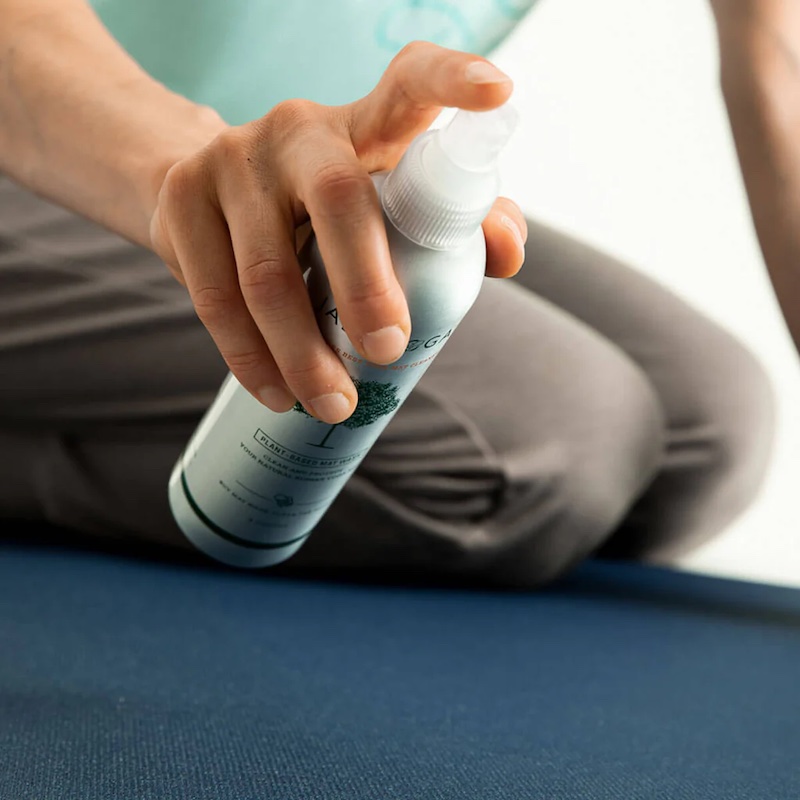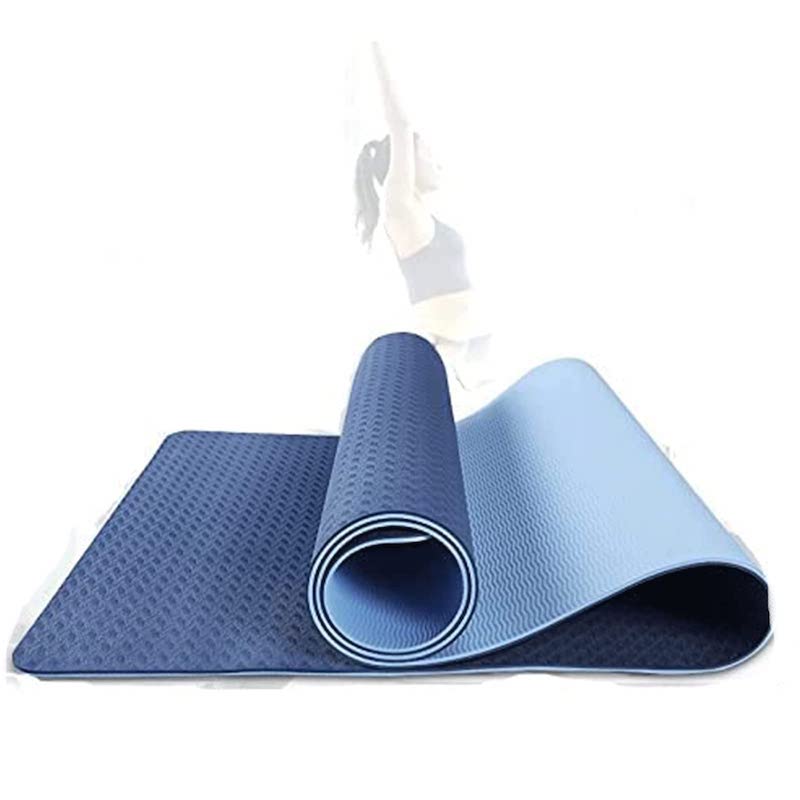Introduction to Yoga Mat Hygiene
Maintaining yoga mat hygiene is essential for several reasons. It protects your health, keeps your mat in good condition, and improves your practice. A clean mat is vital for preventing the buildup of bacteria and fungi. These can cause unpleasant odors and potentially skin irritations. Proper mat hygiene also helps maintain the mat’s grip, ensuring safety during poses.
Regular cleaning removes sweat, oils, and dirt that accumulate with each practice. It extends the longevity of the mat, making it a worthy investment for any dedicated yogi. With the outbreak of COVID-19, cleaning and disinfecting your mat has become more crucial than ever. It helps prevent the spread of the virus, especially if you attend public yoga classes.
When cleaning your yoga mat, it’s important to identify the type of mat you own. Different materials require specific care. For instance, mats with ‘closed cell’ construction, like the PRO series, do not absorb liquids. This makes them easier to clean on the surface. In contrast, ‘open cell’ mats, like the GRP series, are more absorbent and need careful attention to avoid moisture retention.
Using the correct cleaning products is key to effective mat maintenance. Commercial mat cleaners, like Manduka’s Mat Wash & Refresh, are formulated for yoga mats. These products avoid damage that household cleaners can cause. They also contain essential oils and other natural ingredients for a fresh, clean scent.
In addition to regular cleaning, knowing when to perform a deep clean is part of proper mat care. A deep clean helps to remove embedded dirt and restore the mat’s texture.
Embracing these cleaning practices will not only keep your mat fresh but also enhance your yoga experience. Stay tuned for specific care instructions for different types of yoga mats and tips on daily cleaning routines.
Identifying Your Yoga Mat Type
Knowing your yoga mat type is key before cleaning it. Mats vary in material and structure. This affects how you should clean and maintain them.
PRO Series Mat Care
PRO Series mats feature ‘closed cell’ technology. This makes them non-absorbent. For daily care, wipe with Mat Wash & Refresh post-practice. Never soak in water. Dry the mat before storing.
For deep cleaning, spray until wet, let sit, then scrub gently. Ensure mat is dry before use or storage.
eKO Series Mat Care
Made of natural rubber, eKO Series mats are also ‘closed cell’. Use Natural Rubber Yoga Mat Restore for cleaning. Don’t soak or shower this mat. Dry thoroughly post-cleaning. Avoid sunlight and soap to preserve mat integrity.
GRP Series Mat Care
GRP mats are ‘open cell’ and absorb moisture well. They are designed for maximum grip when damp. Cleanse these with Yoga Mat Wash and Refresh. Avoid disinfectants; they get absorbed, hindering proper cleaning. Wipe with a damp cloth, rinse, and let dry fully before storage.
Foundation Series Mat Care
Foundation Series mats like Manduka X use TPE ‘closed cell’ material. Treat with Mat Wash & Refresh for regular maintenance. Spray and wipe carefully, especially if the mat is textured. Deep clean without soaking and dry completely before rolling up.
Daily Cleaning Tips for Yoga Mats
Yoga enthusiasts must clean their mats regularly. Daily cleaning keeps your mat fresh and extends its lifespan. Use soft cloths and appropriate cleaners, like Manduka’s Mat Wash & Refresh, for the task. Avoid using harsh chemicals that could damage your mat or your health.
Utilizing Mat Wash & Refresh
For effective daily cleaning, Manduka’s Mat Wash & Refresh is ideal. It’s designed for yoga mats and includes natural ingredients. Simply spray your mat after practice, wipe with a clean cloth, and let it air dry. This routine prevents dirt build-up and preserves your mat’s texture.
Avoiding Common Cleaning Mistakes
Don’t let common errors ruin your mat. Never soak or submerge your yoga mat in water. This can lead to waterlogging, especially for open-cell mats like the GRP series. Avoid using soap and harsh detergents, as they can break down the mat material. Also, steer clear of abrasive sponges that could scratch the surface. Lastly, always dry your mat completely before rolling it up to prevent mold and odor.
The Deep Cleaning Process
While regular maintenance helps keep your yoga mat clean, sometimes a deep clean is necessary. A deep clean eliminates deep-seated dirt and restores the mat’s texture and grip. Here’s how to perform a thorough deep clean on your yoga mat.
Steps for a Thorough Deep Clean
Begin by preparing a solution of warm water and mild detergent or a specialized yoga mat cleaner. Submerge the mat in the mixture, allowing it to soak for some minutes but not too long. After soaking, use a soft cloth to gently scrub both sides of the mat, paying extra attention to areas with visible dirt or stains. Once you have scrubbed the mat, rinse it thoroughly under running water to remove any soap residue.
If your mat is heavily soiled or hasn’t been cleaned in a while, consider using a soft brush. A brush can help remove stubborn grime. However, use gentle motions to avoid damaging your mat.
Proper Rinsing and Drying Techniques
Rinsing your mat well is key to removing all cleaning solutions, which can make your mat slippery if left behind. After rinsing, avoid wringing out your mat as this can damage its structure. Instead, lay it flat on a clean towel to absorb excess water. Then, hang your mat in a shaded, airy space to dry completely. Direct sunlight can degrade the quality of certain mat materials, so it’s best to dry away from harsh rays.
Make sure your mat is fully dry before storing it. Rolling up or using a damp mat can lead to mold, mildew, and odors. With your mat clean and dry, you’re ready for your next yoga session on a fresh, inviting surface.
Disinfecting Your Yoga Mat
Disinfecting your yoga mat is essential, especially during flu seasons or pandemics. Not all cleaning removes germs. Disinfecting targets harmful bacteria and viruses directly. Knowing when to disinfect and what products to use is crucial.
When to Disinfect
Disinfect your mat often if you practice in public spaces. High-touch surfaces can carry germs. After each public class, consider disinfecting. If you practice at home, disinfecting less often may be fine. However, if someone is sick or during a health crisis like COVID-19, disinfect weekly at least.
You do not need to disinfect after every home session. But if your mat is dirty or you sweat a lot, clean it. When disinfecting, ensure you do it safely and effectively.
Suitable Disinfectants for Different Mat Types
Choose disinfectants carefully. Not all mats tolerate the same treatment. For mats like the PRO Series, use a spray like Manduka’s Mat Wash & Refresh. It’s safe and made for these mats.
Avoid harsh chemicals like bleach. They can damage your mat and your skin. For the GRP Series, avoid moisture-absorbing disinfectants. They are harder to clean out.
If you don’t have commercial products, you can use a solution with essential oils. Check the manufacturer’s recommendations first.
For mats that can handle moist cleaning, a natural option is a mix of water and vinegar. Add a few drops of tea tree or lavender oil for their antibacterial properties. Remember to rinse well and let the mat dry completely.
Disinfecting is a key step in maintaining your yoga mat. Use the right cleaners to keep your mat safe for your health and longevity.

DIY Natural Yoga Mat Cleaners
Creating your own natural yoga mat cleaner is simple and cost-effective. Not only does it help you maintain a clean mat, but it also provides peace of mind knowing you’re not using harsh chemicals. Below we’ll explore a recipe and some tips for creating your own cleaner using materials you likely have at home.
Homemade Yoga Mat Cleaner Recipe
For a quick and easy DIY yoga mat cleaner, you only need a few items. Grab a spray bottle and combine three parts filtered water with one part white vinegar, which acts as a natural disinfectant. Then, add 10-30 drops of tea tree oil for its potent antibacterial properties. Optionally, you can add about 10 drops of another antibacterial essential oil, like lavender or peppermint, for a pleasant scent.
Here’s how to make it:
- Fill a spray bottle with the water and vinegar.
- Add the tea tree oil and optional essential oil.
- Shake the bottle to mix the ingredients.
To use, lightly spray one side of your mat, let it sit for a few minutes, then wipe clean with a damp cloth. Flip the mat and repeat. Allow your mat to air dry completely before rolling it back up.
Tips for Using Essential Oils in Mat Cleaners
Essential oils can enhance your yoga mat cleaner with natural scents and extra cleaning power. However, it’s important to use them correctly. Here are some tips:
- Choose essential oils known for their antibacterial qualities, like tea tree or eucalyptus.
- Always dilute essential oils in water as they are highly concentrated.
- Do a spot test on your mat to ensure the oils don’t cause any damage.
- Avoid using too much oil to prevent any residue that could make the mat slippery.
- Consult your mat’s manufacturer recommendations, as some mats like those from Jade or Lululemon might not be suited for oil-based cleaners.
Through these natural solutions, you can keep your yoga mat clean and fresh without the need for harsh chemicals.
General Mat Maintenance and Care
Proper yoga mat maintenance extends its life and keeps your practice hygienic. Include these care steps in your routine.
Storage and Handling Best Practices
Store your yoga mat in a cool, dry place. Avoid folding as this can damage its shape. Instead, roll your mat with the practice side in to keep it clean. If your mat gets wet during practice, let it dry fully before storing to prevent mildew and odor.
Keep your yoga mat away from sharp objects to prevent tears. Also, keep it out of long-term direct sunlight, which can degrade certain materials. Lastly, carry your mat in a bag when traveling to protect it from the elements.
FAQs on Yoga Mat Maintenance and Care
- How often should I clean my yoga mat?Clean your mat after every practice to remove sweat and oils. Deep clean monthly or when needed.
- Can I use any cleaner on my yoga mat?Use cleaners recommended by your mat’s manufacturer. Avoid harsh chemicals that can break down mat materials.
- Is it okay to leave my yoga mat in my car?It’s best not to. Extreme temperatures can affect the mat’s material and shape.
- How do I know if my mat is ‘closed cell’ or ‘open cell’?Check the manufacturer’s specifications. ‘Closed cell’ mats don’t absorb moisture while ‘open cell’ mats do.
- Can I use alcohol to clean my yoga mat?Generally, no. Alcohol can dry out and degrade the mat’s materials. Use a cleaner designed for yoga mats instead.


